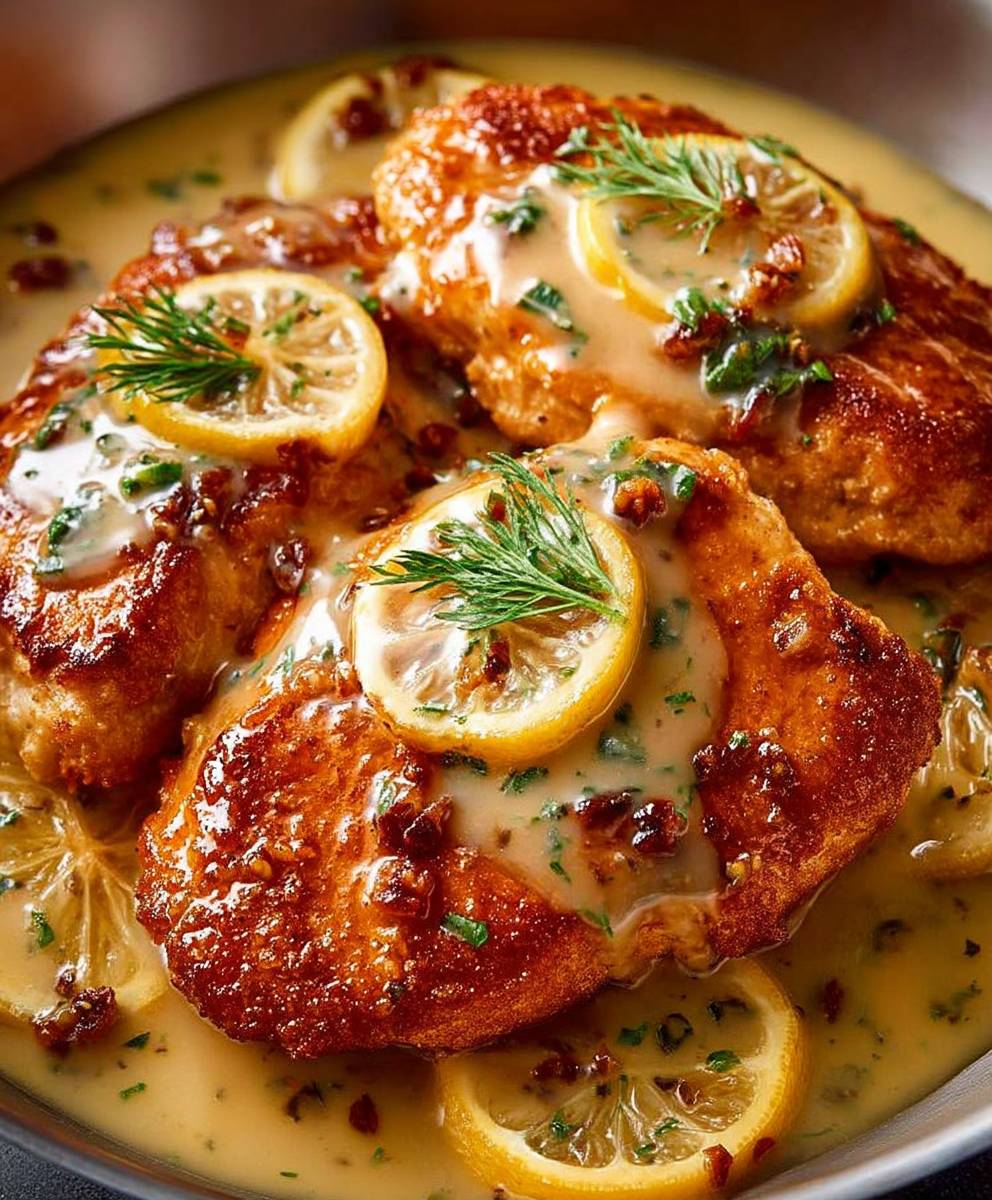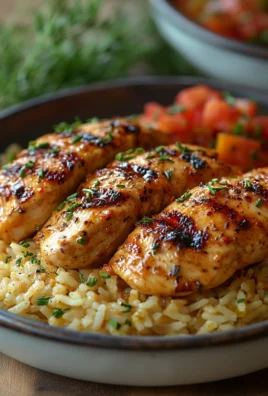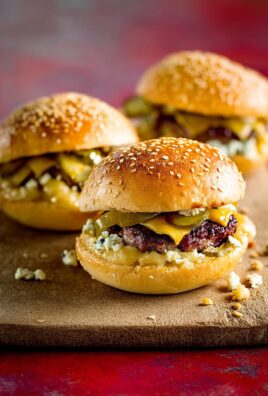Chicken Francese, oh, where do I even begin? Imagine sinking your teeth into a tender, pan-fried chicken breast, enveloped in a light, lemony, and buttery sauce that just dances on your tongue. It’s a symphony of flavors and textures that will leave you craving more. This isn’t just dinner; it’s an experience!
While its exact origins are debated, Chicken Francese is widely believed to have emerged from Italian-American kitchens, possibly as a variation of veal dishes prepared alla francese (in the French manner). It cleverly utilizes simple ingredients to create a dish that feels both elegant and comforting. It’s a testament to the ingenuity of home cooks who adapted traditional techniques to available resources.
What makes this dish so universally loved? Well, beyond the sheer deliciousness, it’s incredibly versatile. It’s quick enough for a weeknight meal but impressive enough to serve to guests. The bright, citrusy sauce cuts through the richness of the butter and chicken, creating a perfectly balanced flavor profile. The tender, almost melt-in-your-mouth texture of the chicken, thanks to the egg batter, is simply irresistible. Plus, it pairs beautifully with pasta, rice, or a simple side of vegetables. Trust me, once you try this Chicken Francese recipe, it will become a staple in your culinary repertoire!
Ingredients:
- 4 boneless, skinless chicken breasts (about 6 ounces each)
- 1 cup all-purpose flour
- 1 teaspoon salt
- 1/2 teaspoon black pepper
- 3 large eggs
- 1/4 cup milk
- 1/4 cup grated Parmesan cheese
- 1/2 cup olive oil
- 1/2 cup butter
- 1 cup dry white wine (such as Pinot Grigio or Sauvignon Blanc)
- 1/2 cup chicken broth
- 1/4 cup fresh lemon juice
- 2 tablespoons chopped fresh parsley, for garnish
- Lemon wedges, for serving
Preparing the Chicken:
- First, we need to prepare the chicken breasts. Place each chicken breast between two sheets of plastic wrap. Using a meat mallet or rolling pin, pound the chicken to an even thickness of about 1/4 inch. This helps them cook quickly and evenly.
- In a shallow dish, combine the flour, salt, and pepper. Mix well to ensure the seasoning is evenly distributed. This seasoned flour will create a lovely crust on the chicken.
- In another shallow dish, whisk together the eggs, milk, and Parmesan cheese. Make sure the mixture is smooth and well combined. The Parmesan adds a nice savory note to the egg wash.
Cooking the Chicken:
- Now comes the fun part cooking the chicken! Heat the olive oil and butter in a large skillet over medium-high heat. The combination of oil and butter gives the chicken a beautiful golden color and rich flavor. Make sure the skillet is large enough to accommodate the chicken breasts without overcrowding. If necessary, cook the chicken in batches.
- Dredge each chicken breast in the seasoned flour, shaking off any excess. We want a light coating, not a thick layer.
- Dip the floured chicken breast into the egg mixture, ensuring it’s fully coated. Let any excess egg drip off before placing it in the hot skillet.
- Carefully place the chicken breasts in the hot skillet. Cook for about 3-4 minutes per side, or until golden brown and cooked through. The internal temperature should reach 165°F (74°C). Use a meat thermometer to be sure!
- Remove the cooked chicken breasts from the skillet and set them aside on a plate. Cover them loosely with foil to keep them warm while you prepare the sauce.
Making the Francese Sauce:
- With the chicken set aside, it’s time to make the delicious Francese sauce. In the same skillet (don’t wipe it out those browned bits are full of flavor!), pour in the white wine. Bring it to a simmer and scrape up any browned bits from the bottom of the pan. This is called deglazing, and it adds so much depth of flavor to the sauce.
- Let the wine reduce by about half, which should take about 5-7 minutes. This concentrates the flavor and thickens the sauce slightly.
- Add the chicken broth and lemon juice to the skillet. Stir to combine.
- Continue to simmer the sauce for another 3-5 minutes, or until it has thickened slightly. You want it to be able to coat the back of a spoon.
- Reduce the heat to low. Swirl in 2 tablespoons of butter. This adds richness and a beautiful sheen to the sauce. Stir until the butter is melted and fully incorporated.
- Taste the sauce and adjust the seasoning as needed. You may want to add a pinch of salt or pepper, or a little more lemon juice for extra tang.
Serving the Chicken Francese:
- Now for the best part serving! Place the cooked chicken breasts back into the skillet with the sauce. Spoon the sauce over the chicken, ensuring it’s nicely coated.
- Let the chicken simmer in the sauce for a minute or two to warm through. This allows the flavors to meld together beautifully.
- Garnish with chopped fresh parsley. The parsley adds a pop of color and freshness.
- Serve the Chicken Francese immediately. It’s delicious served with pasta, rice, or a simple side salad. Don’t forget the lemon wedges for squeezing over the chicken!
Tips and Variations:
- Pounding the Chicken: Pounding the chicken to an even thickness is crucial for even cooking. If the chicken is too thick in some areas, it will take longer to cook, and the thinner areas may become dry.
- Wine Choice: A dry white wine like Pinot Grigio or Sauvignon Blanc works best in this recipe. Avoid sweet wines, as they will make the sauce too sweet. If you don’t have white wine, you can substitute with more chicken broth, but the flavor won’t be quite the same.
- Parmesan Cheese: The Parmesan cheese in the egg wash adds a lovely savory flavor. You can experiment with other cheeses, such as Pecorino Romano, but Parmesan is the classic choice.
- Sauce Consistency: The sauce should be thick enough to coat the back of a spoon. If it’s too thin, continue to simmer it until it reduces to the desired consistency. If it’s too thick, add a little more chicken broth.
- Gluten-Free Option: To make this recipe gluten-free, use a gluten-free all-purpose flour blend. Ensure that all other ingredients are also gluten-free.
- Adding Capers: For a briny twist, add 2 tablespoons of capers to the sauce along with the lemon juice.
- Serving Suggestions: Chicken Francese is delicious served with a variety of sides. Try it with:
- Linguine or spaghetti tossed with olive oil and garlic
- Roasted asparagus or broccoli
- Mashed potatoes
- A simple green salad with a lemon vinaigrette
- Make Ahead: You can prepare the chicken breasts ahead of time by pounding them and dredging them in the flour and egg mixture. Store them in the refrigerator until ready to cook. The sauce can also be made ahead of time and reheated before serving.
Troubleshooting:
- Chicken is Dry: If your chicken is dry, it’s likely overcooked. Be sure to pound the chicken to an even thickness and cook it just until it reaches an internal temperature of 165°F (74°C).
- Sauce is Too Thin: If your sauce is too thin, continue to simmer it until it reduces to the desired consistency. You can also add a cornstarch slurry (1 tablespoon cornstarch mixed with 2 tablespoons cold water) to thicken it.
- Sauce is Too Thick: If your sauce is too thick, add a little more chicken broth until it reaches the desired consistency.
- Chicken is Not Golden Brown: If your chicken isn’t getting golden brown, make sure the skillet is hot enough and that you’re using a combination of olive oil and butter. Also, avoid overcrowding the skillet, as this will lower the temperature and prevent the chicken from browning properly.
Nutritional Information (Approximate):
(Note: Nutritional information is an estimate and may vary based on specific ingredients and portion sizes.)
- Calories: Approximately 450-550 per serving
- Protein: 40-50g
- Fat: 25-35g
- Carbohydrates: 15-25g
Enjoy your delicious homemade Chicken Francese! I hope this recipe helps you create a restaurant-quality dish in your own kitchen. Don’t be afraid to experiment and adjust the recipe to your own taste. Happy cooking!

Conclusion:
This isn’t just another chicken recipe; it’s an invitation to experience a little bit of culinary magic right in your own kitchen. The bright, lemony sauce, the tender, pan-fried chicken it all comes together to create a dish that’s both elegant and comforting. Trust me, once you’ve tasted this Chicken Francese, you’ll understand why I’m so passionate about it. It’s a guaranteed crowd-pleaser, perfect for a weeknight dinner that feels special or a weekend gathering where you want to impress.
But what truly sets this recipe apart is its versatility. While I’ve shared my go-to method, feel free to experiment and make it your own! For a richer flavor, try using brown butter instead of regular butter for the sauce. The nutty notes will add a whole new dimension to the dish. If you’re looking for a lighter option, you can use chicken cutlets instead of breasts, which will cook even faster.
Serving suggestions? Oh, the possibilities are endless! My personal favorite is to serve it over a bed of creamy mashed potatoes, allowing the luscious sauce to soak in. Alternatively, you can pair it with a simple side of steamed asparagus or green beans for a lighter, healthier meal. For a more Italian-inspired experience, serve it alongside some perfectly cooked linguine or spaghetti. Toss the pasta with a little of the Francese sauce and a sprinkle of Parmesan cheese pure heaven!
And don’t forget the wine! A crisp, dry white wine like Pinot Grigio or Sauvignon Blanc will complement the lemony flavors of the dish beautifully. If you prefer red wine, a light-bodied Pinot Noir would also be a great choice.
Beyond the classic pairings, consider these variations:
* Spice it up: Add a pinch of red pepper flakes to the sauce for a subtle kick.
* Herb it up: Incorporate fresh herbs like parsley, thyme, or oregano into the sauce for added depth of flavor.
* Make it vegetarian: Substitute the chicken with thick slices of eggplant or portobello mushrooms for a delicious vegetarian option. Just be sure to dredge them in flour and egg before pan-frying, just like the chicken.
* Add some capers: A tablespoon or two of capers added to the sauce at the end will provide a delightful burst of salty, briny flavor.
I’ve poured my heart and soul into perfecting this Chicken Francese recipe, and I’m confident that you’ll love it as much as I do. It’s a dish that’s both easy to make and incredibly satisfying to eat. It’s one of those recipes that you’ll find yourself making again and again, adapting it to your own tastes and preferences.
So, what are you waiting for? Gather your ingredients, put on some music, and get cooking! I promise you won’t regret it. And most importantly, don’t be afraid to have fun in the kitchen. Cooking should be an enjoyable experience, a chance to express your creativity and nourish yourself and your loved ones.
Once you’ve tried this recipe, I’d absolutely love to hear about your experience. Did you make any modifications? What did you serve it with? What did your family and friends think? Share your photos and stories in the comments below! Your feedback is invaluable, and it helps me to continue creating recipes that you’ll love. Happy cooking!
Chicken Francese: The Ultimate Guide to Making It Perfectly
Tender, pan-fried chicken breasts in a luscious lemon-butter-wine sauce. A classic Italian-American dish that's quick, easy, and bursting with flavor!
Ingredients
- 4 boneless, skinless chicken breasts (about 6 ounces each)
- 1 cup all-purpose flour
- 1 teaspoon salt
- 1/2 teaspoon black pepper
- 3 large eggs
- 1/4 cup milk
- 1/4 cup grated Parmesan cheese
- 1/2 cup olive oil
- 1/2 cup butter
- 1 cup dry white wine (such as Pinot Grigio or Sauvignon Blanc)
- 1/2 cup chicken broth
- 1/4 cup fresh lemon juice
- 2 tablespoons chopped fresh parsley, for garnish
- Lemon wedges, for serving
Instructions
- Place each chicken breast between two sheets of plastic wrap. Using a meat mallet or rolling pin, pound the chicken to an even thickness of about 1/4 inch.
- In a shallow dish, combine the flour, salt, and pepper. Mix well.
- In another shallow dish, whisk together the eggs, milk, and Parmesan cheese until smooth.
- Heat the olive oil and butter in a large skillet over medium-high heat.
- Dredge each chicken breast in the seasoned flour, shaking off any excess.
- Dip the floured chicken breast into the egg mixture, ensuring it’s fully coated. Let any excess egg drip off.
- Carefully place the chicken breasts in the hot skillet. Cook for about 3-4 minutes per side, or until golden brown and cooked through (internal temperature of 165°F/74°C).
- Remove the cooked chicken breasts from the skillet and set them aside on a plate. Cover loosely with foil to keep warm.
- In the same skillet, pour in the white wine. Bring to a simmer and scrape up any browned bits from the bottom of the pan.
- Let the wine reduce by about half (5-7 minutes).
- Add the chicken broth and lemon juice to the skillet. Stir to combine.
- Continue to simmer the sauce for another 3-5 minutes, or until it has thickened slightly.
- Reduce the heat to low. Swirl in the remaining butter until melted and fully incorporated.
- Taste the sauce and adjust the seasoning as needed.
- Place the cooked chicken breasts back into the skillet with the sauce. Spoon the sauce over the chicken.
- Let the chicken simmer in the sauce for a minute or two to warm through.
- Garnish with chopped fresh parsley.
- Serve immediately with pasta, rice, or a side salad. Serve with lemon wedges.
Notes
- Pounding the chicken ensures even cooking.
- Use a dry white wine like Pinot Grigio or Sauvignon Blanc.
- Parmesan cheese adds a savory flavor to the egg wash.
- The sauce should be thick enough to coat the back of a spoon.
- For a gluten-free option, use gluten-free all-purpose flour.
- Add 2 tablespoons of capers to the sauce for a briny twist.
- Serve with linguine or spaghetti tossed with olive oil and garlic, roasted asparagus or broccoli, mashed potatoes, or a simple green salad with a lemon vinaigrette.
- You can prepare the chicken breasts ahead of time by pounding them and dredging them in the flour and egg mixture. Store them in the refrigerator until ready to cook. The sauce can also be made ahead of time and reheated before serving.





Leave a Comment